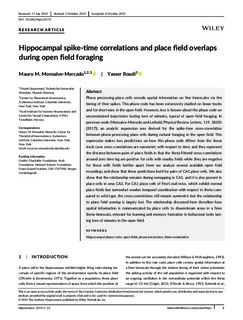| dc.contributor.author | Monsalve-Mercado, Mauro | |
| dc.contributor.author | Roudi, Yasser | |
| dc.date.accessioned | 2019-12-05T07:08:48Z | |
| dc.date.available | 2019-12-05T07:08:48Z | |
| dc.date.created | 2019-12-04T11:52:28Z | |
| dc.date.issued | 2019 | |
| dc.identifier.citation | Hippocampus. 2019, 1-13. | nb_NO |
| dc.identifier.issn | 1050-9631 | |
| dc.identifier.uri | http://hdl.handle.net/11250/2631826 | |
| dc.description.abstract | Phase precessing place cells encode spatial information on fine timescales via the timing of their spikes. This phase code has been extensively studied on linear tracks and for short runs in the open field. However, less is known about the phase code on unconstrained trajectories lasting tens of minutes, typical of open field foraging. In previous work (Monsalve‐Mercado and Leibold, Physical Review Letters, 119, 38101 (2017)), an analytic expression was derived for the spike‐time cross‐correlation between phase precessing place cells during natural foraging in the open field. This expression makes two predictions on how this phase code differs from the linear track case: cross‐correlations are symmetric with respect to time, and they represent the distance between pairs of place fields in that the theta‐filtered cross‐correlations around zero time lag are positive for cells with nearby fields while they are negative for those with fields further apart. Here we analyze several available open field recordings and show that these predictions hold for pairs of CA1 place cells. We also show that the relationship remains during remapping in CA1, and it is also present in place cells in area CA3. For CA1 place cells of Fmr1‐null mice, which exhibit normal place fields but somewhat weaker temporal coordination with respect to theta compared to wild type, the cross‐correlations still remain symmetric but the relationship to place field overlap is largely lost. The relationship discussed here describes how spatial information is communicated by place cells to downstream areas in a finer theta‐timescale, relevant for learning and memory formation in behavioral tasks lasting tens of minutes in the open field. | nb_NO |
| dc.language.iso | eng | nb_NO |
| dc.publisher | Wiley | nb_NO |
| dc.rights | Navngivelse-Ikkekommersiell 4.0 Internasjonal | * |
| dc.rights.uri | http://creativecommons.org/licenses/by-nc/4.0/deed.no | * |
| dc.title | Hippocampal spike‐time correlations and place field overlaps during open field foraging | nb_NO |
| dc.type | Journal article | nb_NO |
| dc.type | Peer reviewed | nb_NO |
| dc.description.version | publishedVersion | nb_NO |
| dc.source.pagenumber | 1-13 | nb_NO |
| dc.source.journal | Hippocampus | nb_NO |
| dc.identifier.doi | https://doi.org/10.1002/hipo.23173 | |
| dc.identifier.cristin | 1756492 | |
| dc.description.localcode | © 2019 The Authors. Hippocampus published by Wiley Periodicals, Inc. This is an open access article under the terms of the Creative Commons Attribution‐NonCommercial License, which permits use, distribution and reproduction in any medium, provided the original work is properly cited and is not used for commercial purposes. | nb_NO |
| cristin.unitcode | 194,65,60,0 | |
| cristin.unitname | Kavliinstitutt for nevrovitenskap | |
| cristin.ispublished | true | |
| cristin.fulltext | original | |
| cristin.qualitycode | 1 | |

